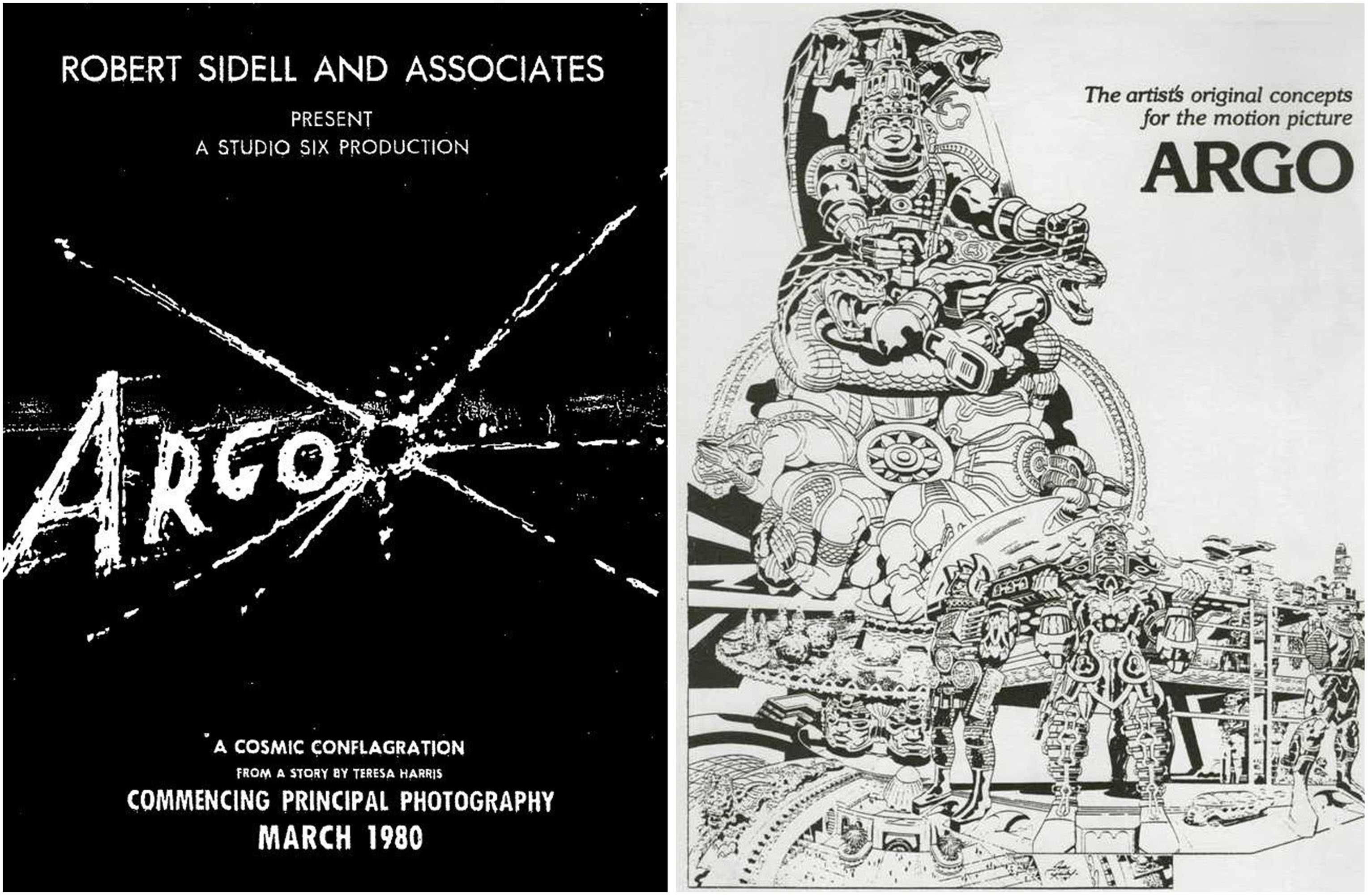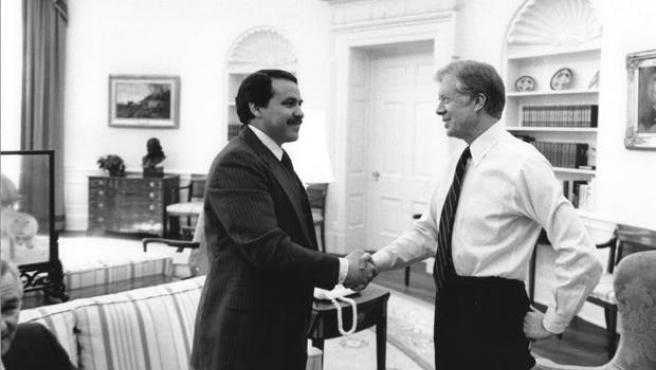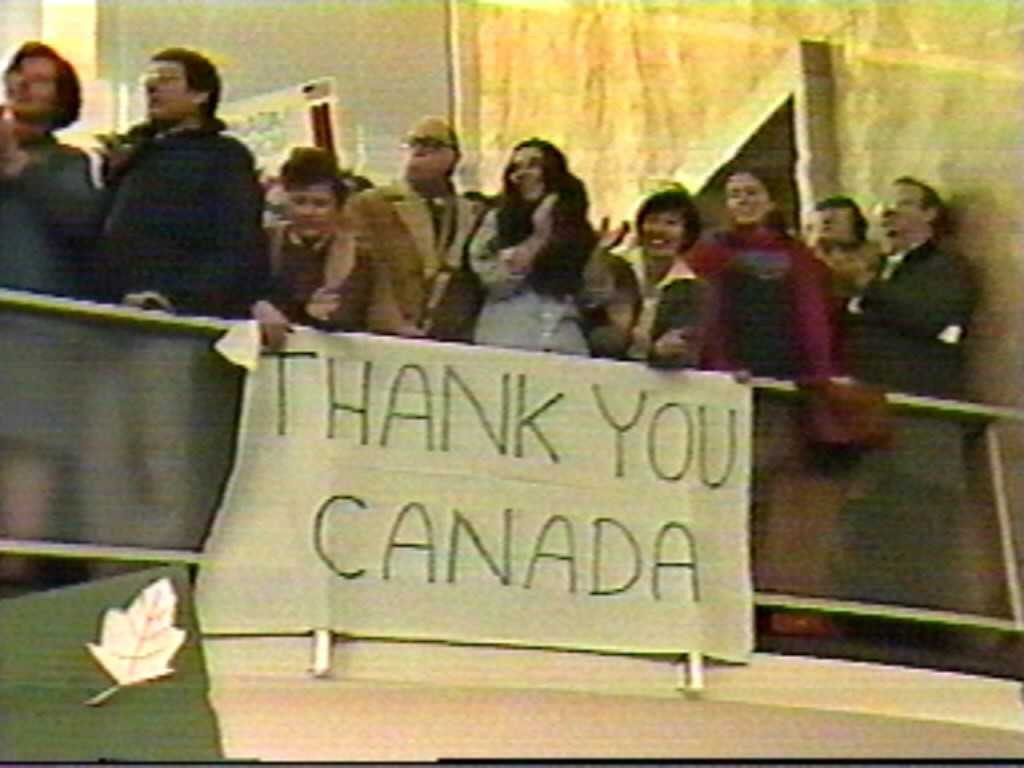A National Crisis Unfolds
November 4, 1979. Militant Islamic students stormed the U.S. Embassy in Tehran, Iran and held 66 U.S. personnel hostage. Most of the hostages were in captivity for 444 days until their release in January 1981. However, six U.S. State Department staff evaded capture, taking refuge in the homes of Canadian Embassy officers.

Iranian students climb over the wall of the U.S. Embassy in Tehran on November 4, 1979 [STR/AFP via Getty Images].
The emergency situation put Washington on full-alert. While decision-makers mulled options to address the crisis, Tony Mendez, a CIA officer who specialized in supporting covert operations, masterminded the elaborate plan that was ultimately chosen. The mission was to exfiltrate the six U.S. diplomats, or in other words, sneak them out of the country. It would involve a small team of CIA disguise, false documentation, and graphics specialists, as well as a savvy motion picture consultant.
Ottawa agreed to grant Canadian passports to the “Canadian Six” (as they became known)—two young married couples, Joseph and Kathleen Stafford and Mark and Cora Lijek, and two single men, Bob Anders and Lee Schatz—for humanitarian purposes. With that, CIA set its plan in motion. A plan so unbelievable, it was believable.
Hatching the Rescue Plan
Tony reached out to acclaimed Hollywood make-up artist and CIA contractor John Chambers, who produced the masks for the film Planet of the Apes (1968), and relayed his wild idea to pass the six Americans off as a Canadian film crew, who had only been in Iran a few days to scout desert locations and were set to depart for their next global destination. Together they brought the deception to life.
First, they established a fake movie production company, Studio Six Productions, to serve as a cover for the operation. They set up offices on the old Columbia Studio lot formerly occupied by Michael Douglas, who had just completed production on the thriller, The China Syndrome (1979). To make the cover seem even more authentic, Tony designed a Studio Six Productions logo for business cards with a phone number routed to individuals in on the ruse. Script readings were staged. It was all so realistic that actual producers—among them, Steven Spielberg—sent film proposals. Studio Six could have been a lucrative venture!
John recalled his previous work with comic and sci-fi fanatic Barry Ira Geller on a screenplay adaptation of the novel “Lord of Light” and knew of concept artwork created by one of the comic book industry’s most influential artists, Jack Kirby. The movie script and artwork would be a perfect fit for the exfiltration plan.
Studio Six titled its Middle Eastern-themed sci-fi production Argo—a nod to Greek mythological hero Jason who commanded the ship “Argo” on a quest to reclaim the Golden Fleece—advertised it, and borrowed the Geller screenplay and Kirby artwork to fool the Iranians into believing the film scouting expedition was legit. The recent success of Star Wars (1977) reinforced the so-called Argo scheme.

Movie poster for the cover movie Argo (left). Artist concept adapted for the cover movie Argo (right).
Executing the Mission
“PRESIDENT HAS JUST APPROVED THE FINDING. YOU MAY PROCEED ON YOUR MISSION TO TEHRAN. GOOD LUCK”
Receiving this final go-ahead from President Jimmy Carter on January 23, 1980, Tony and another CIA specialist set off for Tehran—with Argo paraphernalia and alias documentation in hand—to link up with the Canadian Six and prepare them for the exfiltration. Meanwhile, Canada shipped the false passports and forged travel documentation to the Canadian Embassy in Tehran via secure diplomatic pouch.
Tony and his colleague touched down in Tehran on January 25, 1980 and met with the Canadian Embassy staff and the “houseguests” they had been sheltering. Since going into hiding, the six had passed the time cooking and mastering the game of Scrabble, and now, they had just two days to rehearse their cover stories as members of a motion picture production crew from Canada. Fortunately, they were in high spirits and seemed to grasp the details of their individual covers.
The Americans scrounged clothes from one another to add to their cover personas. Each was having great fun playing their part and hamming it up. The strait-laced diplomats became Hollywood chic—silk shirts, gold chains with medallions, and all.
After their last supper in hiding, one of the Canadian diplomats fluent in Farsi volunteered to conduct a mock interrogation of the six Americans to prepare them for what they might encounter at the airport. The volunteer, donning military fatigues and playing the role of an Islamic Revolutionary Guard official, inspired the houseguests to take their cover seriously.
The stakes were high. The U.S. diplomats had no background in intelligence work. Failure posed a considerable risk of embarrassment to the U.S. and Canadian governments and would reflect badly on CIA. Most importantly, failure threatened the safety of all involved.
Tony sent a cable to Washington and Ottawa outlining the final details of the exfiltration plan the night before the group of Americans were scheduled to depart. Policymakers were pleased with the action plan and cabled their response with the sign off:
“SEE YOU LATER, EXFILTRATOR.”
The Great Escape
January 28, 1980. 3:00 a.m. Tony was jolted out of sleep in his dark hotel room by the phone ringing next to his bed. It was the big day. The Embassy attaché was in the lobby waiting to drive him to the airport. Tony had overslept but managed to shower and dress within 15 minutes.
The employees at Tehran’s Mehrabad Airport were still groggy when he arrived. And, at this early hour, the place was nearly empty of travelers. So far so good. The representative at the Swissair counter confirmed that the 7:30 a.m. flight was on-time. Swissair had a record of efficient and reliable service.
Soon, the houseguests arrived, as did Tony’s colleague. Everyone seemed bright, eager, and dressed the part. Canadian maple leaf stickers were plastered onto their luggage for added effect. With bated breath, the U.S. diplomats and their two CIA-escort “production managers” passed through Customs and Immigration without a hitch. The immigration officer could not have cared less about the “film crew.”
As the Americans wandered about the gift shops in the departure terminal like ordinary tourists, a few fatigue-clad Revolutionary Guards stood around scrutinizing everyone. The group excitedly moved toward the gate once the Swissair flight was called. It would be a short bus ride to the aircraft from there.
Just then, a blaring announcement over the PA system dashed the group’s hopes for freedom. The Swissair flight was delayed for departure because of mechanical problems. Different flights soon arrived, filling up the gate area. Tony started to sweat and sought the Canadian Embassy attaché, who had been monitoring from a distance. The attaché learned that the mechanical problem was minor and that the delay should not be too long.
Everyone waited on edge while roving Revolutionary Guards continued their random inspections of other travelers. After a tense hour, the Swissair flight was called once again. This time, for real.
Tony later shared that as the group started up the ramp to board the aircraft, Bob Anders nudged him on the arm and said, “You arranged for everything, didn’t you!” Coincidentally, lettered across the plane was “Aargau,” a region in Switzerland.
A collective sigh of relief came over the Canadian Six when the plane cleared Iranian airspace.

Then-President Jimmy Carter (right) congratulates CIA officer Tony Mendez (left) on his successful Argo operation, 1980.
Victory with the Help of Friends
News of the escape and Canada’s support quickly broke. Americans went wild in celebrating their appreciation to Canada and its Embassy staff. The maple leaf flag flew in cities and towns across the U.S., and billboards exclaimed, “Thank you Canada!”

Jubilant Americans expressing gratitude for Canada after the rescue of the “Canadian Six.”
CIA’s role, however, was a closely held secret until 1997, when it was revealed to the public during the Agency’s fiftieth anniversary commemoration.
Real vs. Reel: Movie Comes Full Circle
More than a decade after the Argo exfiltration mission was declassified, Argo (2012) was in the works, and this time, it was a real film with Hollywood calling on CIA. Argo director Ben Affleck, who portrayed Tony Mendez, used Tony as a technical adviser and consulted with other current and former CIA officers to make sure he correctly captured the look and feel of the Agency in the 1970s. In fact, Tony still had the exact jacket and pants he wore during the operation for costume designers to replicate.

Ben Affleck filming for Argo (2012) in the lobby of CIA Headquarters (left). Tony Mendez (right).
![Scene from 2012 Argo film on the left. The real “Canadian Six” meeting with President Carter in 1980 on the right [Photo courtesy Mark Lijek].](/static/2bff56f4a7c8aeac4784122c38658d5c/6d667/Argo_Six.jpg)
Scene from 2012 Argo film (left). The real “Canadian Six” meeting with President Carter in 1980 (right) [Photo courtesy Mark Lijek].
Prior to filming at CIA Headquarters, CIA asked Affleck about his research for the role and if anything about CIA surprised him. “Mostly what I learned, and what I intend to show, is the way the Agency is not The Bourne Identity or Jack Ryan. While I like those movies, I was much more interested in a place where thousands of Americans come to work each day, in a large office building, doing often thankless work—and all in the service of their country. I learned that so many of the people at the CIA are ‘ordinary’ people who are paying their mortgage and raising their family. And who just happen to be doing exceptional work for their country.”
The Argo exfiltration was a joint effort between two nations that brought six Americans back home to freedom. Argo is one of CIA’s great successes, and its lessons of innovation and partnership inspire our technical intelligence officers as the Agency forges new pathways into the future.
